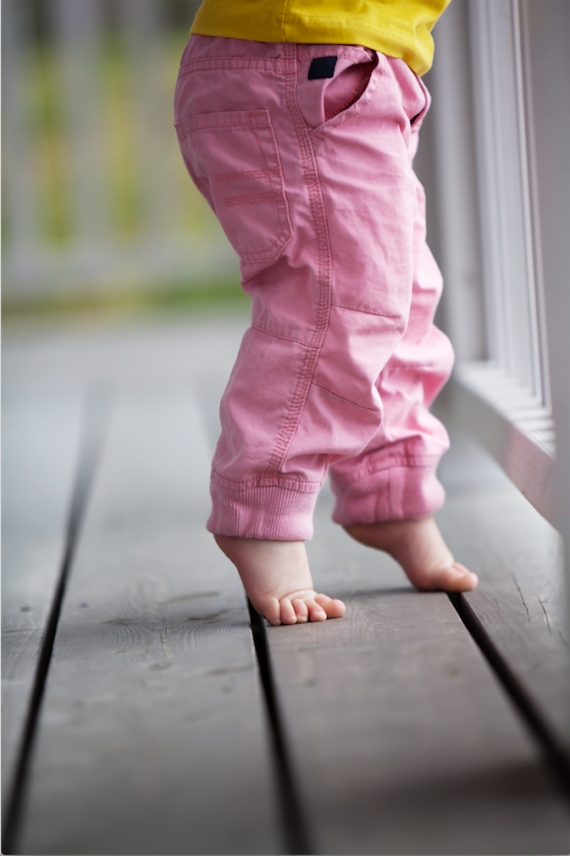What is Toe Walking?
Toe walking simply means that the child walks up on the balls of their feet instead of walking with a heel-to-toe pattern. Toe walking is something frequently treated at our clinic. But how do you know if toe walking is something to be concerned about?
Some amount of toe walking is normal and expected for children as they explore movement as young walkers. Toe walking is considered normal within 6 months of the start of independent walking. A child should be walking with their feet flat on the floor by 2 years of age and should be walking with a heel-to-toe pattern by 3 years of age.1
Although we do not want to see children walking on their toes all of the time, it is important for toddlers and children to be able to walk on the balls of their feet to increase calf strength required for running and jumping. If you notice your child is past 2 years of age and demonstrates toe walking more than 50% of the, it may be time to seek out intervention.
Why is Toe Walking a Concern?
Although toe walking seems harmless, it can impact your child’s safety during walking and gross motor play. Toe walking puts the child at an increased risk of tripping and falling because they are not picking up the front of their foot, causing decreased clearance between their foot and the ground. Many parents of children who toe walk report that their child may trip and fall if he or she is not watching where they are walking.2
Toe walking also decreases the child’s base of support, which makes it harder for them to balance. If you try to stand on your toes instead of flat feet, you will notice that your body sways more and you may feel unsteady. This unsteadiness makes it harder to balance during walking, jumping and hopping. As the child continues to toe walk, their heel cords become tight and their ankle dorsiflexors (muscles that lift the foot upward) become weak. This can make stair navigation, squatting and jumping more difficult because of this decreased flexibility and strength. Some children even have difficulty pedaling a bicycle because of the tightness in their calf muscles. Decreased ankle dorsiflexor range of motion is also correlated with an increased frequency of ankle injuries.3
How Can I Correct My Child’s Toe Walking?
Children may demonstrate toe walking for several reasons including high muscle tone, low muscle tone, sensory processing dysfunction, and idiopathic (unknown cause). A physical therapist can help you find the underlying cause of toe walking. If the underlying issue is sensory related, then an evaluation from an occupational therapist may be needed, too. Therapy may include stretching, joint and soft tissue mobilization, manual therapy, strengthening, taping, electrical stimulation, bracing and gait training. 4 A therapist will also give you different tools to facilitate these activities at home so your child can get all the practice he or she needs both inside and outside of the clinic.
Tracy Shilling, PT, D
References:
- 1.Shulman LH, Sala DA, Chu MLY, McCaul PR, Sandler BJ. Developmental implications of idiopathic toe walking. The Journal of Pediatrics. 1997;130(4):541–546. doi:10.1016/s0022-3476(97)70236-1.
- 2.Gormley ME, Herring GM, Gaebler-Spira DJ. The use of botulinum toxin in children: A retrospective study of adverse reactions and treatment of idiopathic toe-walking. European Journal of Neurology. 1997;4(SUPPL.2):27–30.
- 3.Tabrizi P, McIntyre WMJ, Quesnel MB, Howard AW. Limited dorsiflexion predisposes to injuries of the ankle in children. The Journal of Bone and Joint Surgery. 2000;82(8):1103–1106. doi:10.1302/0301-620x.82b8.10134.
- 4.Le Cras S, Bouck J, Brausch S, Taylor-Haas A; Cincinnati Children’s Hospital Medical Center: Evidence-based clinical care guideline for Management of Idiopathic Toe Walking, http://www.cincinnatichildrens.org/service/j/andersoncenter/evidence-based-care/occupational-therapy-physicaltherapy/, Guideline 040, pages 1-17, February 15, 2011.

